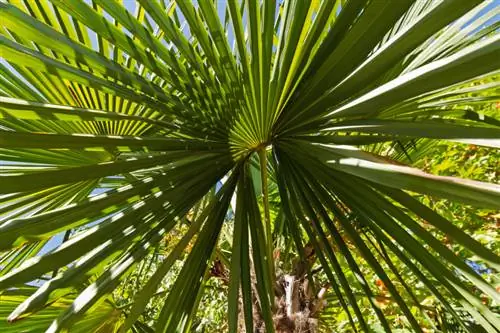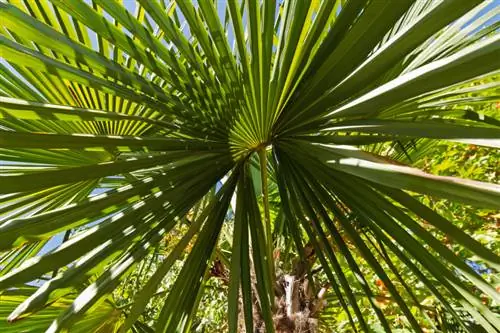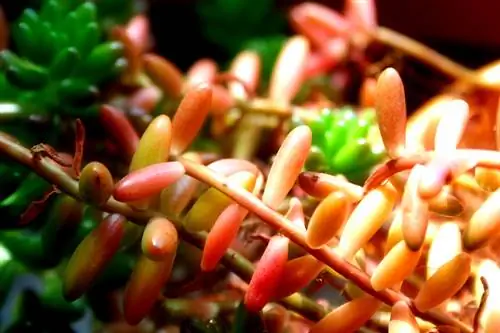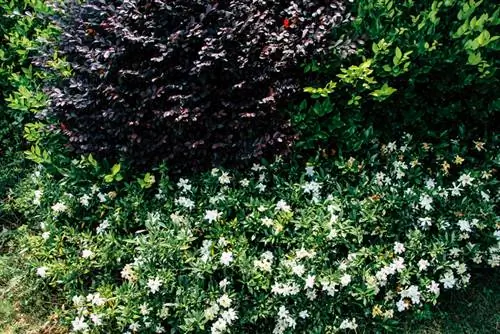- Author admin [email protected].
- Public 2023-12-25 17:45.
- Last modified 2025-01-23 11:22.
If you come across a palm tree planted outdoors in the local regions, it is usually a hemp palm. As a paragon of robust resistance and frugal undemanding, this fan palm has conquered the hearts of gardeners. Are you dealing with unanswered questions about cultivation? Then you will receive a tried and tested answer.

How do you properly care for a hemp palm?
The hemp palm (Trachycarpus) is a hardy fan palm that thrives in sunny, wind-protected locations. It requires humus-rich, nutrient-rich, well-drained soil and regular watering with soft water. Your care includes removing dead leaves and fertilizing from April to September.
Plant hemp palm correctly
Before you plant a fan palm outdoors, it should be given careful care in the pot for 3-5 years. Only plant your exotic garden resident in spring. If the hemp palm comes into the ground in April or May, it will be well established in the ground by the beginning of winter. Assign a Trachycarpus a sunny, wind-protected and warm location where the soil is humus and well-drained. Dig a planting hole that fully accommodates the long taproot. Enrich the excavation with compost, horn shavings, lava granules and bog soil. This is how the procedure works:
- Create a drainage at the bottom of the pit made of expanded clay or pottery shards
- Take the hemp palm out of the pot and place it in the ground, taking into account the previous planting depth
- Press the optimized substrate firmly so that no cavities form at the roots
- Watering with soft water and mulching with leaves or grass clippings
In the first 2 weeks, place a parasol over the palm tree if it moves outside from the protected environment of a living room or greenhouse.
Care tips
Exemplary palm tree care has far fewer hurdles than is generally assumed. If the chosen location largely meets the requirements, care revolves around the following aspects:
- Water the hemp palm thoroughly with soft water when the substrate surface dries
- Fertilize every 14 days from April to September or apply a slow-release fertilizer in April and June
- Cut off yellowed, dead fronds so that a residue approx. 20 cm long remains on the trunk
In the bed, the fan palm is hardy down to -10 degrees. In severe frost, tie up the fronds and cover them with breathable fleece. Pile the tree disc up to 30 cm high with leaves, straw or fir branches.read more
Which location is suitable?
The hemp palm prefers a sunny location with humus-rich, nutrient-rich and well-drained soil. Although the fronds are sturdy, a wind-protected location is ideal for harmonious growth. You can also place the plant in partial shade; Here, however, the typical silhouette falls short of expectations.read more
What soil does the plant need?
A hemp palm should spend its first years of life in a pot filled with permeable, humus-rich substrate. If you choose loose soil with coarse components that has a slightly acidic pH value, the plant will feel in good hands. Older specimens thrive in any good garden soil, as long as it is nutritious and well-drained. As we get older, soil acidity fades into the background. Nevertheless, it is an advantage if you optimize clay-containing garden soil with leaf compost or peat as well as a few handfuls of lava granules.read more
What is the best time to plant?
Plant a hemp palm outdoors only in spring. During the months of April and May, a date with mild, dry weather is possible. In this way, the palm plant has a sufficiently long phase to root vitally in the ground until winter. If you cultivate the fan palm in a bucket and overwinter indoors, you can plant it at any time during the growing season.
When is flowering time?
From April to June, yellow to yellowish-green panicle flowers appear on older hemp palms. Pollination only occurs if both a palm tree with male flowers and a specimen with female flowers are in the immediate vicinity or if some hermaphrodite flowers form next to the female ones. If fertilization occurs, the plant develops dark blue, kidney-shaped berries in autumn.
Cut hemp palm correctly
Only cut off the dead, yellow or brown leaves with a sharp knife. Wait until a frond has completely died before cutting. Until then, it will still release valuable nutrients to the palm tree. Do not cut into he althy tissue and leave a 10-20 cm long piece of leaf sheath on the trunk. This then bends downwards and dissolves into countless fibers. This creates the typical, hairy appearance of the palm trunk. Please note that the tip of a hemp palm is never cut off. The only point of vegetation is here.read more
Watering the hemp palm
Water a fan palm regularly and thoroughly without causing waterlogging. Especially during dry summer weather, you can encourage growth with regular watering. The exotic plant should not be bothered by hard tap water. Instead, use collected rainwater or soft pond water so that the lime content in the substrate does not reach harmful alkaline levels.read more
Fertilize hemp palm properly
Fertilize a hemp palm every 14 days from April to September with a nitrogen-based palm fertilizer (€7.00 at Amazon). Alternatively, administer a long-term preparation in April and June. A liquid fertilizer is recommended for keeping in containers, as it is easier to dose and apply. A combined nutrient supply can also be considered in the bed. After initial mineral fertilization in April, a portion of compost with horn shavings takes over the nutritional supply every 2 weeks.read more
Wintering
A snow-covered palm tree evokes astonished glances over the garden fence in these regions. Thanks to a hardy hemp palm, you can accomplish this gardening feat without extensive prior knowledge. How to overwinter a fan palm successfully:
- From -10 degrees Celsius, tie the fronds together upright
- To protect the sensitive palm heart, put a breathable fleece over it
- Cover the tree disc with leaves, straw and needles
- If there is a clear frost, water every now and then on a mild day
In the pot, however, the outdoor season for a fan palm ends at -5 degrees Celsius. Due to the exposed position of the root ball, it freezes within a short time. Therefore, clear the plant away in good time. The hemp palm proves to be flexible when it comes to light and temperature conditions. Overwintering in a bright, frost-free room at 5-8 degrees Celsius is tolerated, as is staying in a heated, sunny living room at 20 degrees. Adjust the water supply to the temperature conditions accordingly.read more
Propagate hemp palm
Sowing seeds is the only option for propagation. Given the high effort involved due to a germination time of 12-14 months, this project is rarely undertaken by hobby gardeners.read more
Hemp palm in a pot
If you cultivate a young hemp palm in a pot for the first few years, the plant will prepare itself excellently in this protected environment for later planting outdoors. Since the fan palm always spends several years in the same container and substrate, the following planting process is extremely relevant:
- Create a drainage system made of potsherds or expanded clay (no grit or gravel) above the water drain in the deep palm planter
- Spread an air- and water-permeable fleece over it so that no earth crumbs get in between them
- Pour high-quality, permeable and slightly acidic palm soil up to half the height
- Unpot the young hemp palm and insert it into the substrate while maintaining the previous planting depth
Water the young plant thoroughly with soft water and place it in a partially shaded location for a few days until it moves to a sunny location after 8-10 days. Fertilization is carried out for the first time after 6 weeks.
Hemp palm not blooming
The hemp palm only decides to bloom under optimal conditions at an advanced age. Be patient during the first 5-8 years. If an older specimen does not bloom, check the site conditions. A hemp palm only decides to sprout its flowers in sun-drenched, protected locations. If the palm tree lacks nutrients or suffers from drought stress, it will also not bloom.
Yellow leaves
If the fan leaves gradually turn yellow from the tips, it is a completely natural process. The frond is nearing the end of its lifespan and releases its remaining nutrients to the palm. Since a yellow leaf is usually not shed, cut it off. A remainder of 20 cm long remains on the trunk. If a hemp palm does not undergo this horticultural intervention, over the years the yellow leaves will collect under the green fronds, so that the crown takes on an elongated shape.read more
How do I treat brown tips on a hemp palm?
As a result of dry heating air or slight frostbite, the tips of a palm frond can turn brown. Cut off the discolored areas with sharp scissors, leaving a small 1 mm edge of brown tissue on the leaf. If the damage results from dry air, spray the hemp palm with soft water every 2 days. You can protect the plant against renewed frostbite by tying the fronds upright in severe frost and protecting them with a garden fleece.
Should I cut off the flower of a hemp palm?
The growth of male and female flowers costs a hemp palm an enormous amount of energy. As a rule, the already slow growth slows down further. In addition, wilted flowers do not fall off, but instead hang sadly down the trunk on wrist-thick stems. Therefore, cut off a hemp palm flower unless you intend to harvest the seeds.read more
Trivia
Due to its robust growth and winter hardiness, the hemp palm has now found a place on the black list of invasive plants. In Switzerland, experts are even sounding the alarm because the fan palm is increasingly spreading in the mountain forests and threatening the native flora and fauna. For the hobby gardener, this aspect is, on the one hand, confirmation that the palm tree can survive a Central European winter in the garden without any problems. On the other hand, special care is required to prevent a palm tree invasion. This means that clippings should not be disposed of in the forest. The flowers, which are not particularly decorative in any case, are cut off before seeds form. Fruit-bearing clippings are ideally disposed of in the local incineration plant.
Beautiful varieties
- Chinese hemp palm: Most popular fan palm for the garden, balcony and living room with a growth height of 200-400 cm
- Darjeeling: Impresses with fir-green fronds up to 1 m in diameter and robust winter hardiness
- Double trunks: Premium variety among hemp palms with a slender trunk and semicircular compartments
- Wagner’s hemp palm: Short-growing variety, ideal for keeping in containers and small gardens






